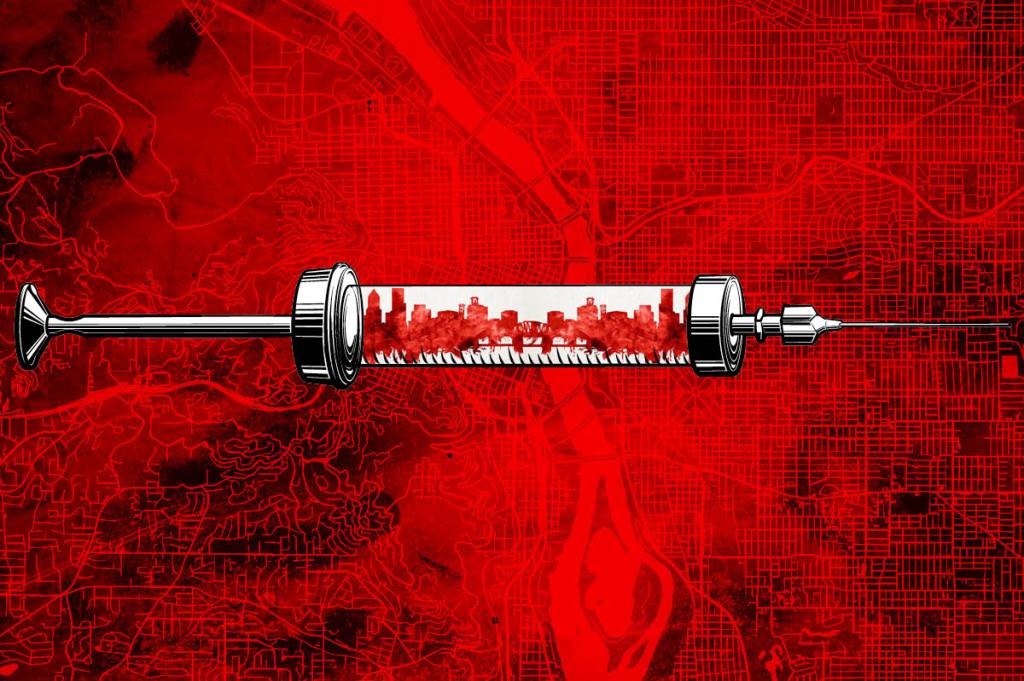In February on a snowy Wednesday, I met a homeless man named David standing outside a Safeway panhandling for money. He was wearing a white hoodie with the words “Portland State University” printed on it and holding two empty beer cans and a remote control.
I asked him what it’s like to be homeless in Portland. “I know how not to be homeless, but there’s a reason I am out here and something’s not right,” he replied. He told me that when he gets housed, he often gets kicked out quickly and doesn’t want to have to go through the effort again. Something bad happened to him when he was a kid; when he goes indoors, he feels closed in and his “demons appear,” he explained. He started using drugs to hide the pain.
He used to use heroin, but became a fentanyl addict because it was cheaper and stronger. His daily fentanyl pill use grew to about twelve to fifteen a day. He switched to fentanyl powder a few months ago because it was easier to smoke. This was when he started getting mysterious sores all over his body. His sores were obvious; I could see at least fifteen on his face and hands. He doesn’t know where they came from, but hypothesized that he was “being poisoned.” I asked if he was experiencing any other symptoms. He said he started “nodding out” for several hours, rather than the normal thirty to sixty minutes.
The term “nodding” is used to describe drifting in and out of consciousness after using drugs. This doesn’t necessarily mean the user is asleep, but his mental capacity has evaporated and he has lost control of his body. Some have described it as a person being in a trance-like state. Opiates are the most common type of drug addicts nod out to because they are a powerful sedative. Fentanyl is an opiate fifty times stronger than heroin, so nodding is extremely common. What is not common for fentanyl use is the length of time David had been knocked out for. It is a sure sign that, unbeknownst to him, he has been taking fentanyl mixed with xylazine, also known as tranq, a veterinary drug used to sedate large animals such as horses or cows.
No one’s sure exactly when addicts began using tranq, but there are records indicating usage in Puerto Rico in the early 2000s. Since then it has slowly started showing up everywhere. Mixing xylazine with fentanyl is a way to enhance the high and make it last longer. One theory about the rise of tranq is that dealers and cartels noticed their customers were developing a tolerance to fentanyl and the demand began to drop. They needed something to keep their customers happy — and found tranq. It seemed to be the perfect choice: it’s cheap and not currently considered a controlled substance. Highs are better and last longer. Everyone is happy.
I spoke to a dealer recently in front of the Portland Art Museum. He’s a low-level dealer that uses an old Diamondback BMX to find customers. He never gets off his bike and always appears to be ready to ride off quickly. As a regular downtown homeless outreach worker, I have seen him working many times. I’m a familiar face to him, so I decided to ask a few questions about tranq. He doesn’t know where the tranq comes from or even when it is added to the fentanyl power he receives, because he does not use fentanyl. “This shit will kill you,” he quipped of the product he sells. He also acknowledged though that when he receives fentanyl laced with tranq, it sells out much more quickly. He made the observation matter-of-factly, without much emotion.
Xylazine was first developed by the Bayer Company in 1962. Ten years later, the FDA approved it as a veterinarian-prescribed sedative as a sedative and pain reliever for animals. The most common species it was used on were horses, cattle and sheep. Drugmakers studied xylazine in humans for the same purposes but ended their clinical trials when it was deemed unsafe. It may not be a controlled substance, but when combined with fentanyl it can be deadly. Side-effects on humans include dead tissue, respiratory depression, disorientation, unconsciousness and even coma. Dead tissue may not sound serious, but an eruption of scaly crust of dead tissue has in some cases led to amputation. One addict I met under an overpass offered a grim description of tranq use: “Flesh will rot off your body.”
This, though, is not the biggest risk that tranq brings. When a person uses just fentanyl, they generally nod out for short periods of time and will likely awaken during an overdose, giving them or others a chance to save them. But because tranq is such a powerful sedative, leaving users unconscious for hours, a person is more likely to overdose and die in their sleep. A person sitting next to them may think the user is having a restless sleep; in fact they are overdosing but can’t scream for help. When they do wake up, say, eight hours later, they are in full-blown withdrawal — because a heavy fentanyl user needs to use about every two hours. To make matters worse, tranq is resistant to Narcan, the life-saving opioid blocker now offered in vending machines around the country.
Many addicts I have talked to know the tranq-fentanyl cocktail is killing them, but they can’t stop. The drugs are highly addictive and part of a coordinated effort by the cartels and dealers keeps their customers dependent. Greg, a homeless addict I met on a cold snowy morning in downtown Portland, explained this relationship. He came to Portland over two years ago from San Antonio. His brother had just died and he wanted to get away. He was invited to Portland to help his friend build a house. The pandemic happened, one thing lead to another and he ended up on the streets. The first thing he noticed was how easy it was to get drugs. “They wanted to all but give them to me,” he said. He described a very friendly man that approached him on his second day being homeless and offered him a small baggie of heroin. He was resistant at first, but, depressed and with a bleak outlook on his future, he accepted it. A day later he was given heroin laced with fentanyl, then pure fentanyl.
When Greg first smoked fentanyl, he said it was life-changing — and not necessarily in a good way. For a short time, all his problems disappeared and he felt more at peace than ever. But that feeling soon wore off and, within a few days, he was desperate for more. He found the man who gave him the baggie, who was now less friendly and wanted money. Greg said this man advised him how to get money by “leading me in to do all these crazy things.” He would not go into details but assured me that people will do anything for their next fix.
A year ago, Greg told me he made a genuine effort to get clean and managed to be drug-free for ten days. He left the area and camped in the Spring Water Corridor, a massive green space with a twenty-one-mile bike trail that winds through it. Once he got through the physical detox, he returned to the neighborhood. Within an hour he was approached and offered a free baggie of fentanyl. He told me a “spotter” saw him and reported his arrival to a dealer, who then got someone else to bring him a taste to get him hooked again. Greg is using heavily again.
This is a lucrative business — and the coordinated effort to get people on drugs and to keep them on drugs is worth it. Giving addicts two or three baggies of free drugs and then selling them hundreds in a year is highly profitable. Greg told me before he was on the streets he went to college and got a degree in biochemistry. He never imagined ending up on the streets and is at a loss as to how he can get clean again. He now only uses fentanyl laced with tranq, due to its long-lasting effects. He acknowledges the grim irony of being a biochemist yet still choosing to use a drug combination that is sure to kill him.
I am a drug and alcohol counselor who has been doing street homeless outreach for over two decades. Fentanyl, and now fentanyl laced with tranq, is the worst thing I have ever seen. Tranq-laced fentanyl is now speeding up an already deadly process. For several years I referred to our homelessness situation as a “humanitarian crisis.” For the last few years, I have said it’s more so a “mental illness and addiction crisis.” Recently my colleague Kate Monroe, a Marine veteran who lives in San Diego told me, “this is not a crisis: this is malicious neglect.” I couldn’t agree more — that’s now the terminology I use.
Our government has been slow to act. The US House passed a bill pledging to “research” tranq last week. And it took until last month for the White House to finally declare xylazine-laced fentanyl an “emerging threat.” That is putting it far too lightly. I have interviewed hundreds of homeless people who have shared with me the truth of their lives on the streets: the languishing, the death and the malicious neglect. They share in often brutally honest and shocking detail what fentanyl has done to them and our communities.
Tranq has taken this already devastating addiction crisis to a grave new level. Rather than recognizing “emerging threats,” we should be in a state of emergency. Several states have already announced the opioid epidemic as exactly that, yet I have not seen any measurable results. Every day that goes by more people fall victim. How many more must die before we take real action?





















